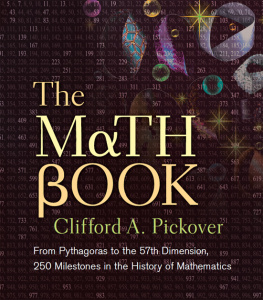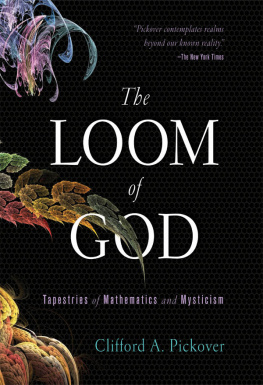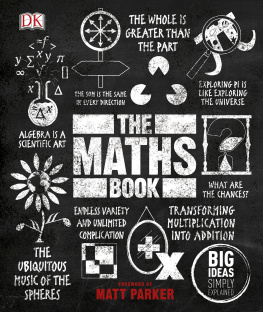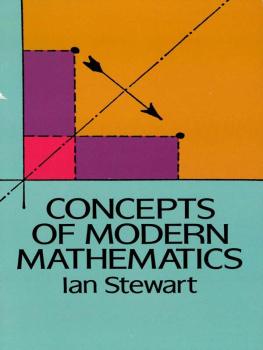
Books by Clifford A. Pickover
The Alien IQ Test
Archimedes to Hawking
A Beginners Guide to Immortality
Black Holes: A Travelers Guide
Calculus and Pizza
Chaos and Fractals
Chaos in Wonderland
Computers, Pattern, Chaos, and Beauty
Computers and the Imagination
Cryptorunes: Codes and Secret Writing
Dreaming the Future
Egg Drop Soup
Future Health
Fractal Horizons: The Future Use of Fractals
Frontiers of Scientific Visualization
The Girl Who Gave Birth to Rabbits
The Heaven Virus
Keys to Infinity
Liquid Earth
The Lobotomy Club
The Loom of God
The Mathematics of Oz
Mazes for the Mind: Computers and the Unexpected
Mind-Bending Visual Puzzles (calendars and card sets)
The Mbius Strip
The Paradox of God and the Science of Omniscience
A Passion for Mathematics
The Pattern Book: Fractals, Art, and Nature The Science of Aliens
Sex, Drugs, Einstein, and Elves
Spider Legs (with Piers Anthony)
Spiral Symmetry (with Istvan Hargittai)
Strange Brains and Genius
Sushi Never Sleeps
The Stars of Heaven
Surfing through Hyperspace
Time: A Travelers Guide
Visions of the Future
Visualizing Biological Information
Wonders of Numbers
The Zen of Magic Squares, Circles, and Stars
The Physics Book

For Martin Gardner
STERLING and the distinctive Sterling logo are registered trademarks of
Sterling Publishing Co., Inc.
Library of Congress Cataloging-in-Publication Data
Pickover, Clifford A.
The math book / Clifford A. Pickover.
p. cm.
ISBN 978-1-4027-5796-9
1. MathematicsHistory. I. Title.
QA21.P53 2009
510.9dc22
2008043214
Published by Sterling Publishing Co., Inc.
387 Park Avenue South, New York, NY 10016
2009 by Clifford A. Pickover
All rights reserved
Sterling ISBN 978-1-4027-9749-1
For information about custom editions, special sales, premium and
corporate purchases, please contact Sterling Special Sales Department at 8008055489 or specialsales@sterlingpublishing.com.
Mathematics, rightly viewed, possesses not only truth, but supreme beautya beauty cold and austere, like that of sculpture.
Bertrand Russell, Mysticism and Logic, 1918
Mathematics is a wonderful, mad subject, full of imagination, fantasy, and creativity that is not limited by the petty details of the physical world, but only by the strength of our inner light.
Gregory Chaitin, Less Proof, More Truth,
New Scientist, July 28, 2007
Perhaps an angel of the Lord surveyed an endless sea of chaos, then troubled it gently with his finger. In this tiny and temporary swirl of equations, our cosmos took shape.
Martin Gardner, Order and Surprise, 1950
The great equations of modern physics are a permanent part of scientific knowledge, which may outlast even the beautiful cathedrals of earlier ages.
Steven Weinberg, in Graham Farmelos
It Must Be Beautiful, 2002
HOW TO USE THIS BOOK
The 250 chronological milestones are easily viewed in the selectable table of contents that follows. Each milestone consists of a synopsis, followed by at least one image that helps to illustrate an aspect of the seminal event, publication, or concept. Occasional text in bold type points the reader to related entries. Additionally, a small See also section at the bottom of each entry helps weave entries together in a web of interconnectedness and may help the reader traverse the book in a playful quest for discovery.
The Beauty and Utility of Mathematics
An intelligent observer seeing mathematicians at work might conclude that they are devotees of exotic sects, pursuers of esoteric keys to the universe.
Philip Davis and Reuben Hersh, The Mathematical Experience
Mathematics has permeated every field of scientific endeavor and plays an invaluable role in biology, physics, chemistry, economics, sociology, and engineering. Mathematics can be used to help explain the colors of a sunset or the architecture of our brains. Mathematics helps us build supersonic aircraft and roller coasters, simulate the flow of Earths natural resources, explore subatomic quantum realities, and image faraway galaxies. Mathematics has changed the way we look at the cosmos.
In this book, I hope to give readers a taste for mathematics using few formulas, while stretching and exercising the imagination. However, the topics in this book are not mere curiosities with little value to the average reader. In fact, reports from the U.S. Department of Education suggest that successfully completing a mathematics class in high school results in better performance at college whatever major the student chooses to pursue.
The usefulness of mathematics allows us to build spaceships and investigate the geometry of our universe. Numbers may be our first means of communication with intelligent alien races. Some physicists have even speculated that an understanding of higher dimensions and of topologythe study of shapes and their interrelationshipsmay someday allow us to escape our universe, when it ends in either great heat or cold, and then we could call all of space-time our home.
Simultaneous discovery has often occurred in the history of mathematics. As I mention in my book The Mbius Strip, in 1858 the German mathematician August Mbius (17901868) simultaneously and independently discovered the Mbius strip (a wonderful twisted object with just one side) along with a contemporary scholar, the German mathematician Johann Benedict Listing (18081882). This simultaneous discovery of the Mbius band by Mbius and Listing, just like that of calculus by English polymath Isaac Newton (16431727) and German mathematician Gottfried Wilhelm Leibniz (16461716), makes me wonder why so many discoveries in science were made at the same time by people working independently. For another example, British naturalists Charles Darwin (18091882) and Alfred Wallace (18231913) both developed the theory of evolution independently and simultaneously. Similarly, Hungarian mathematician Jnos Bolyai (18021860) and Russian mathematician Nikolai Lobachevsky (17931856) seemed to have developed hyperbolic geometry independently, and at the same time.
Most likely, such simultaneous discoveries have occurred because the time was ripe for such discoveries, given humanitys accumulated knowledge at the time the discoveries were made. Sometimes, two scientists are stimulated by reading the same preliminary research of one of their contemporaries. On the other hand, mystics have suggested that a deeper meaning exists to such coincidences. Austrian biologist Paul Kammerer (18801926) wrote, We thus arrive at the image of a world-mosaic or cosmic kaleidoscope, which, in spite of constant shuffling and rearrangements, also takes care of bringing like and like together. He compared events in our world to the tops of ocean waves that seem isolated and unrelated. According to his controversial theory, we notice the tops of the waves, but beneath the surface some kind of synchronistic mechanism may exist that mysteriously connects events in our world and causes them to cluster.
Next page











